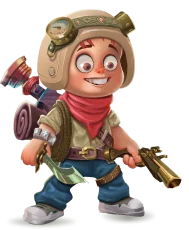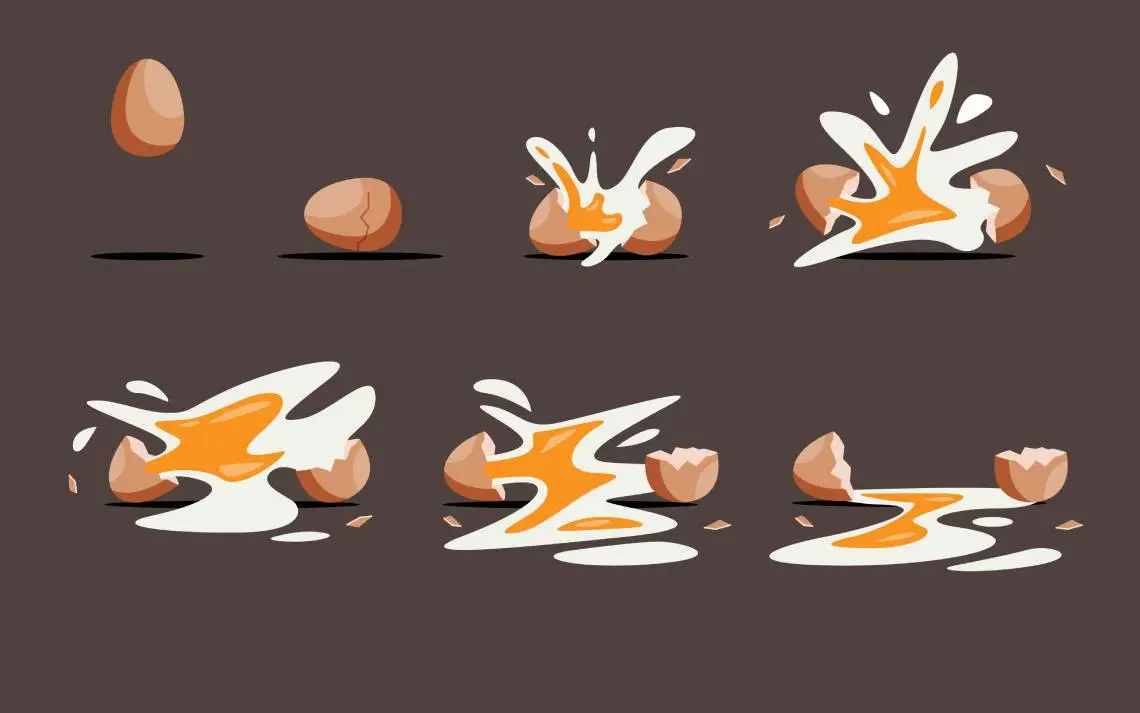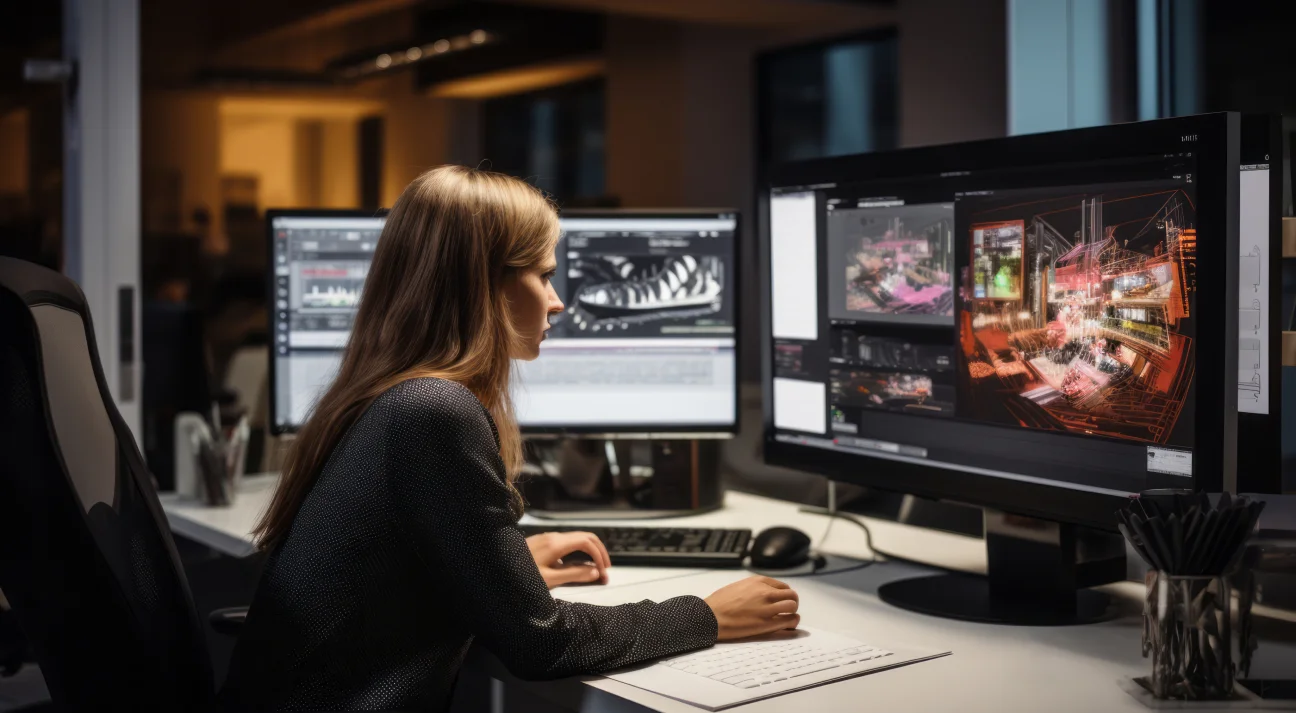
Animation Storyboarding: What is it, Why is it Important, and How to Do it?
Have you ever read a COMIC book or MANGA? Yes, of course, you have! What is the thing that has made you feel excited? It must be the drawn transition between scenes, the vibe, and the effect they create as if they are in sync and you’re witnessing an animated series. Digital animations, which we are witnessing in the name of ANIME or Cartoon, are created through such rendering.
Do you know how much effort was involved in creating such mesmerizing animation? Definitely tons! But do you know how such amazing animation was brought to life? Then, Storyboarding is your answer.
From frame animation to the digital world’s modern animation, storyboards have been an essential part of animation that no artist can overlook. And you should not as well. Hence, you came here all the way down to know about storyboarding for animation in depth.
What is Storyboarding in Animation?
Whenever we talk about creating any Animation, there are three main stages involved: Pre-Production, Production, and Post-Production. And storyboarding is the part of pre-production.
You can call Storyboarding more like a COMIC or rough sketch version of any animation with directions about camera angles, character movements, and scene narrations for animators’ reference to create Animatics and then proper animation.
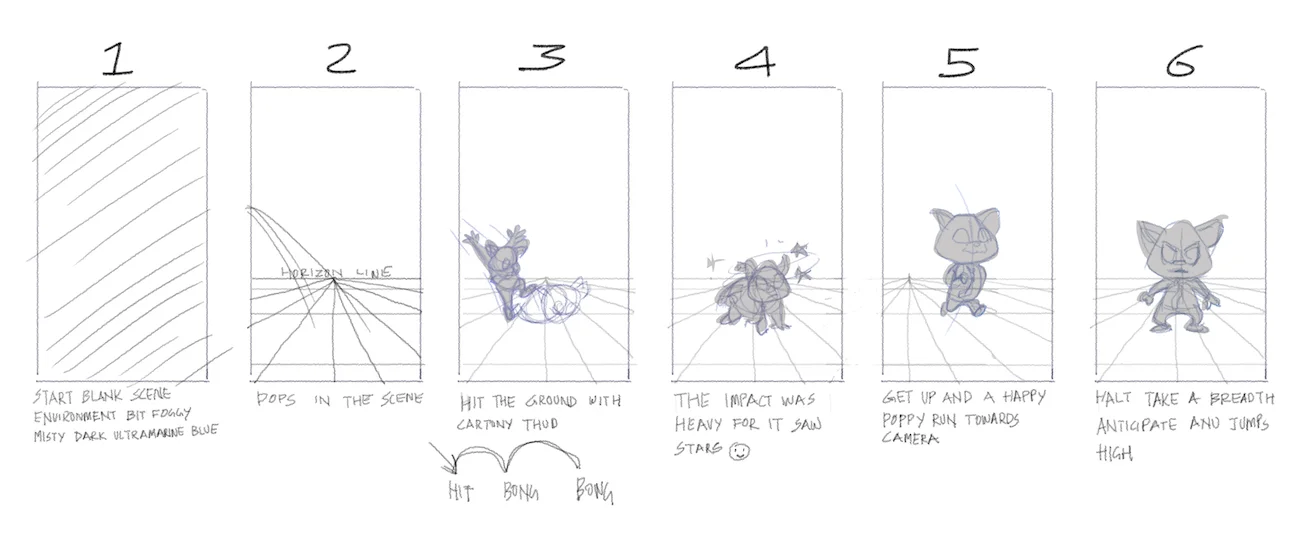
Consider storyboarding the next step just after you have prepared your storytelling for the game, video advertisement, or any sort of animation concept.
In short, an animation storyboard is an approach to illustrating, structuring, and organizing animation scenes, which are brought to life by adding voice acting, transitions, and effects.
Animation storyboard can include:
- Illustration of entire scenes, frame by frame
- The flow, look, and expression of the end product
Depending on the concept, artists may utilize different screens/frames for storyboarding showing the rough visual narration representation of how the particular animation will go. Like we have done for our game Dots & Boxes‘ marketing campaign!
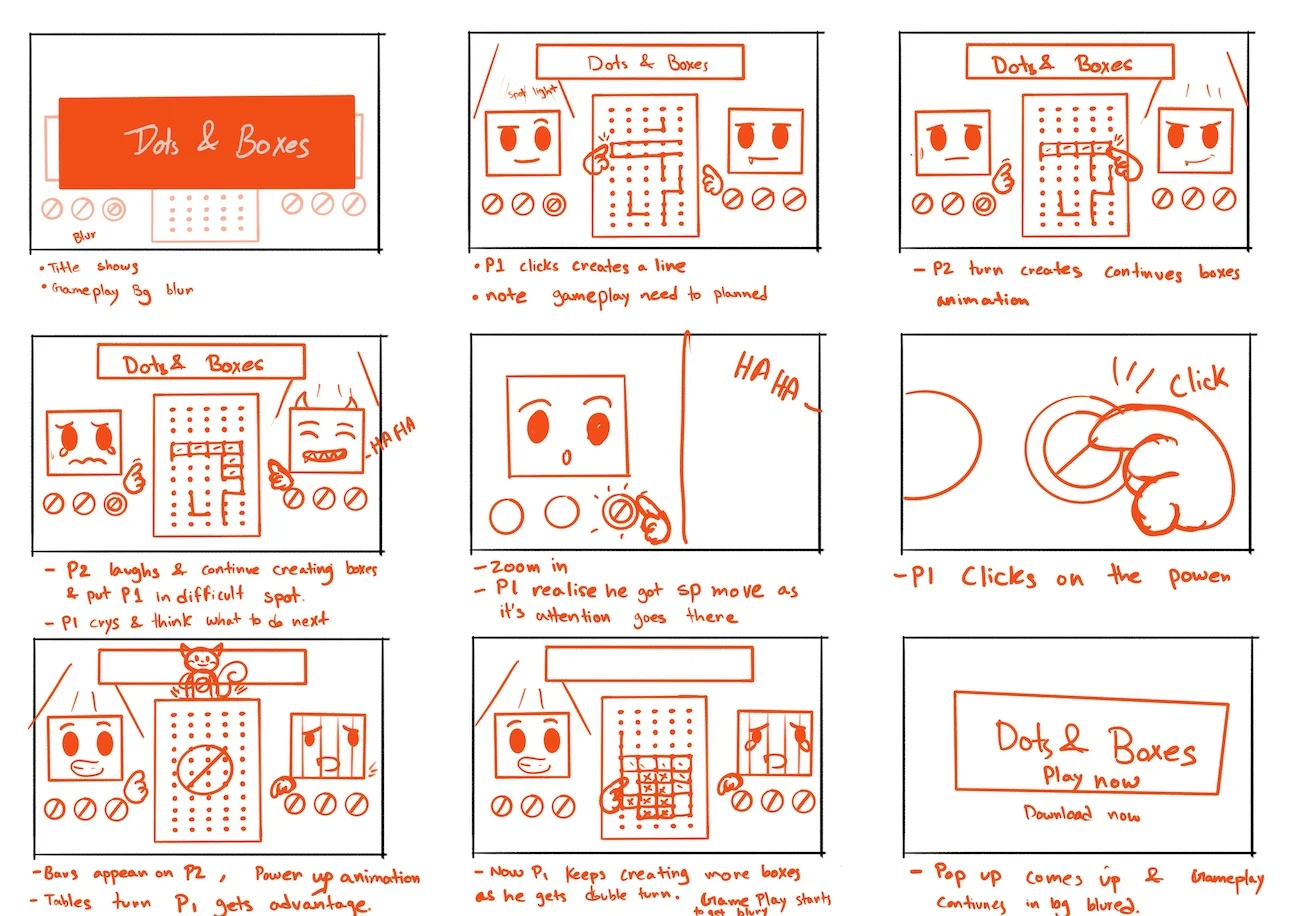
Animation is time-intensive, and to make it start and end within a particular time frame and market it as decided, this storyboarding helps a lot. Based on the time an animator and storyboard artist has and their expertise, storyboarding approaches and types change with it.
Based on the different requirements, here are the different types of storyboards:
- Traditional Pen and Paper-based hand-drawn storyboards are the perfect fit for motion graphics tasks and short video animation project types.
- Digital storyboards that today’s animation and storyboard artists use to cite their thoughts and ideas about the animation frames and motions, which are the best fits for lengthy animation projects. This approach is often followed by artists working at Disney and other big studios.
- Animatics, also known as animation storyboards, are done with the reference of initial storyboarding or can even be done directly as the viewport, which shows the rough animation reference (without that much detail on colors and effects) that tells how the actual animation will seem like as per the concept.
Well, these are the three main types, but you may find other storyboard types, such as written or explainer storyboards with sketches guiding animators.
NOTE: Storyboarding can be done for various purposes, including animated shows/movies, animatics, animated advertisements, narration-based games, and many others.
What are the Advantages of Storyboarding in Animation?
As a movie is directionless without a proper script, Animation is a scattered thing without a concrete drawn storyboard. Apart from that, here are the reasons why you need the help of a storyboard artist to create your impactful, immersive animation piece:
- Having a proper concept and storyboard in a place helps animators to have total clarity of the vision of the piece;
- Visualize endless possibilities for the animation and give animators the perfect plot to fill their magic into;
- Storyboarding helps animators understand and animate the clip while ensuring each scene gets its proper time to shine and is synced in a smooth and engaging flow;
- Guide animators for the composition of individual scenes, like how each character and element should positioned within the frame while balancing visuals and aesthetics;
- Storyboards enable animators to plan character expressions and movements in detail;
- Storyboarding is not just the process of coming up with ideas to animate scenes; it’s the process of bringing out an experience that’s believable, eye-catching, and animated.
In short, with storyboards in place, animators get a lot of time to think more creatively about the color theme and lighting for the animation to make it an immersive experience.
How to Storyboard for Animation?
Depending on the artist’s experience and project concept, the approach for the animation storyboarding changes. Be it a 2D animation, 3D animation, or motion graphics, the process we are going to showcase here is mostly followed by the Storyboard Artists and Animator, especially by our team of artists:
Understanding the Concept
For the storyboard artists and animators, it’s a must to understand the concept and the storyline for which they are going to animate. Because we know, without clarity, the created storyboards and then animation is a mess.
Hence, our team of storyboard artists and animators, before getting started with any animation projects, comes up with tons of questions, like:
- What’s the animation about?
- What kind of expectations do they have for us?
- Do they have any clear message or clarity on the animation that the final product should look like?
These are just a few, but we ask many other questions that would help us get clarity on how to start with any storyboarding projects and ways to collaborate with animators.
When designing the Christmas post in 3D animation, our 3D artist got the basic idea from the stakeholder like what they wanted – a compelling Christmas animation showing the vibe of Christmas, the message to be delivered – wishing Christmas, and animation expectations – a piece that shows our expertise in game development (VR, PC & Console, and Mobile games) and animation services that takes users towards the Christmas vibe intuitively.
So, they came up with this type of animation concept with the perfect transition from desk to ho…ho…ho… vibes:
Define Key Focus Areas
After understanding the idea that stakeholders present in front of us, our storyboard artists break down their key points. This helps us focus on the highlights of the animation, which can be story turning points, character introductions, or significant events that can intrigue the audience to stick to the animation.
Look for Reference and Inspiration
Now that the storyboard artists have understood the concept and even the scenes that need better highlights, looking for references is the next stop. References give artists an idea of what to show and how it will look in the final product.
With the help of references and inspiration, storyboard artists give animators the idea about details to be added, like lighting, the color of the scene, and even the effect, making the entire animated scene just WOW.
At 300Mind, we believe in experiments to bring the creative animation version to life. So, when it comes to references to animate our 3D animation for Christmas day, we have gathered these references for inspiration:

Laying Down the Script
Here can be two scenarios, either the storyboard artist has the full script to portray in the form of scratch directly, or the storyboard artists are just given the concept to come up with the storyline. For this, the entire team of storyboard artists and scriptwriters sit together for the storyboard ideation.
Finalize The Shot
After the rough idea from the inspiration the artist got for the animation storyboards, they can utilize that to finalize the shots, like which thing will come first, how the scenes will develop, and how the narration will take place.
It starts with finalizing the story world/environment building or location, the character/focus object, the activity that the character will do/the object movement takes place, the effects and after effects, and a lot more. This also helps storyboard artists portray the whole narration and vibe of the scene (such as sad, thrill, action-packed, etc.) and its smooth transition frame-by-frame in the sketch format.
In the shot of our latest Christmas post, the artist finalized the transition from the desk to Christmas party revealing all Christmas props.
Start with Thumbnails and Angles
This is where the storyboard designing starts, in which artists take a page consisting of 10-12 or more or fewer frames based on the concept and the level of detail required. This is the main process of putting artistic vision on paper or digital canvas with rough sketches about the visual narration frame-by-frame, which are then rendered together and transitioned into the animation.
For this process, it is often advised to start small with thumbnails in a not-so-detailed version to easily portray the imagination of the artist, like what to include and how it should look. Through this, with the possibilities of imagination, they can create multiple versions of the same scene to come up with the most effective one without investing ample time.
Based on the reference and shot finalized, our 3D artist created this storyboard idea that would focus on the immersion of the audience in the scene and make them stick to it till the end.
Infuse Clarity
Portraying the storyline in the form of a sketch is the initial step the artist has taken toward animation. But after the shot has been finalized with thumbnails, it’s important to ensure a bit of clarity on the sketch for the animator to understand, like how the character is feeling, and behaving, how the other shot objects are moving, and how’s the scenario for that scene.
The clarity in the story and its narration should also be clear in the animation, which starts with storyboarding.
If the character is running away from something, the sketch should reflect that with directions and side effects, like we have seen in comic books and manga. When there’s a sad scene going on, for example, a narration for the death scene, then the storyboard should show the details about the dull light scene or something like that that can give the audience such a vibe.
If the gun is firing up, the sketch should include the effect of the bullet leaving the gun tip, the thrust that the gun and the character feel, and, of course, that spark.
Like, it’s shown in this image:

As we can see in this above image, we can clearly understand what and how that scene is trying to communicate with us, like the flow of the scene and how the action is taking place. It not only explains the flow of the narrations but also the camera angles for better cinematography, or we say in the animation term – animatography.
This approach eliminates the need for the audience to guess what’s happening in the scene, even while looking at the storyboard.
Utilizing this approach, at first, animators create animatics – the motion version of the storyboard to experiment with the narration and effects. After this, they create viewports, which are near the final animation but more like white models or animations without lighting and colors.
How Experts at 300Mind Can Help You With Animation Storyboarding?
Storyboarding is an amazing approach, or you can say, a tool that can help animators save the ample time associated with finalizing the animation flow. Hence, it’s vital to mention all details about the scene, focus on compositions, maintain visual consistency, and smooth transition from one frame to another. And most importantly, think about pacing, camera angles and movements, and clarity in sketches.
When it comes to all these, storyboard artists and 2D/3D animators at 300Mind take care of all these considerations to deliver clients top-notch animation services for their mission. So, share your animation requirements with us and get end-to-end solutions, from ideation to storyboarding to creative animation.
FAQs about Animation Storyboarding
Yes, storyboards are a fundamental and widely used tool in the animation industry. Storyboards serve as a visual blueprint for animators, directors, and other members of the production team.
Deciding on the time to create an animated project may depend on several factors, including the project type, complexity, animation style (2D or 3D), length, graphics used, expertise of the talent, level of detail desired, and a lot more.
Absolutely. Animation has versatile applications beyond entertainment, including education, marketing, medical visualization, simulation, and training. It is a powerful tool for conveying complex information in a visually engaging and accessible manner.
